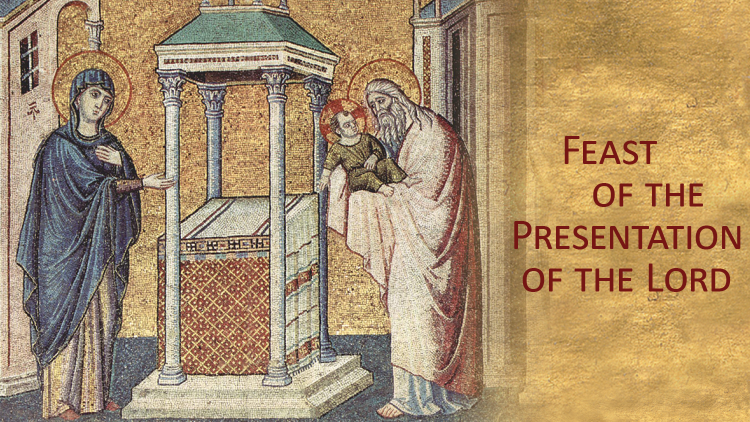
Feast of the Presentation of the Lord
Forty days after Christmas, the Church celebrates the Feast of the Presentation of the Lord, an event that the evangelist Luke recounts in Chapter 2 of his Gospel. In the East, the celebration of this feast dates back to the 4th century. By the year 450, it was called The Feast of the Meeting of the Lord because Jesus enters the Temple and “meets” the priests, as well as Simeon and Anna, representatives of the people of God. Around the middle of the 5th century, we know the feast was also celebrated in Rome. At a certain point, the blessing of candles was added to this feast to recall that Jesus is the “light to the gentiles”. Thus, this feast is also sometimes referred to as Candlemas.
When the days were completed for their purification according to the law of Moses, Mary and Joseph took Jesus up to Jerusalem to present him to the Lord, just as it is written in the law of the Lord, Every male that opens the womb shall be consecrated to the Lord, and to offer the sacrifice of a pair of turtledoves or two young pigeons, in accordance with the dictate in the law of the Lord. Now there was a man in Jerusalem whose name was Simeon. This man was righteous and devout, awaiting the consolation of Israel, and the Holy Spirit was upon him. He came in the Spirit into the temple; and when the parents brought in the child Jesus to perform the custom of the law in regard to him, he took him into his arms and blessed God, saying: “Now, Master, you may let your servant go in peace, according to your word, for my eyes have seen your salvation, which you prepared in the sight of all the peoples: a light for revelation to the Gentiles, and glory for your people Israel.” (Lk. 2:22-25, 27-32)
The offering
According to the Mosaic law, the first-born male was the Lord’s possession and was destined to serve in the temple. Later, when the descendants of Levi, the Levites, assumed this service in the temple, this prescription was no longer enforced. However, the first-born son had to be redeemed with a monetary offering to maintain the priests.
The meeting with Simeon
“He came in the Spirit into the temple”. This is a detail that must be highlighted. Simeon is moved by the inspiration of the Holy Spirit. This explains how he “recognizes” Jesus as the Awaited One, the light of the Gentiles. He is the Light before whom one needs to take a stand: “The true light, which enlightens everyone, was coming into the world…but the world did not know him” (Jn. 1:9, 10).
A sword will pierce your heart
Simeon blesses both parents, but addresses his words only to the Baby’s Mother. The Baby will be a sign of contradiction: Jesus is the light of the world, but He will be rejected. Jesus will be admired and loved, but He will be crucified, defeated. He will die and rise. He will trod the way of contradiction that will pierce His Mother’s heart.
The meeting with Anna
The Prophetess Anna arrives in the Temple too. From the details the Evangelist gives, it is evident that she too is a godly woman. She is elderly, a widow. Her being a “prophetess”, allows her to discern what others find it difficult to see: the presence of God. She knows how to go beyond appearances in order to see the Baby her people have been waiting for.
Wonder
The average age at Jesus’ time was approximately 40 years. But Luke says that both Simeon and Anna were “elderly”. People who are elderly generally live on their memories. They are nostalgic for times gone by. It is the young, instead, who live in hope, who look to the future. In this case, we find before us two old people who, before this Child, look toward the future, who expect something, who are awestruck. They sing of joy and hope. These details make us understand how young at heart they were because God and His promises dwelt in their hearts – and God does not disappoint.
Prophets
We too are involved in this “vision” because all who live the Gospel are and will be signs of contradiction. Courage is required to take a stand before the Lord Jesus, the “Light for revelation”. Even more so, this requires first of all being “of God”, like Simeon and Anna. Furthermore, it requires an awareness that everything will not always be completely clear. After all, Joseph and Mary were “amazed” by what was said. But, as we know, before this difficulty, Mary “kept all these things, pondering them in her heart”.








